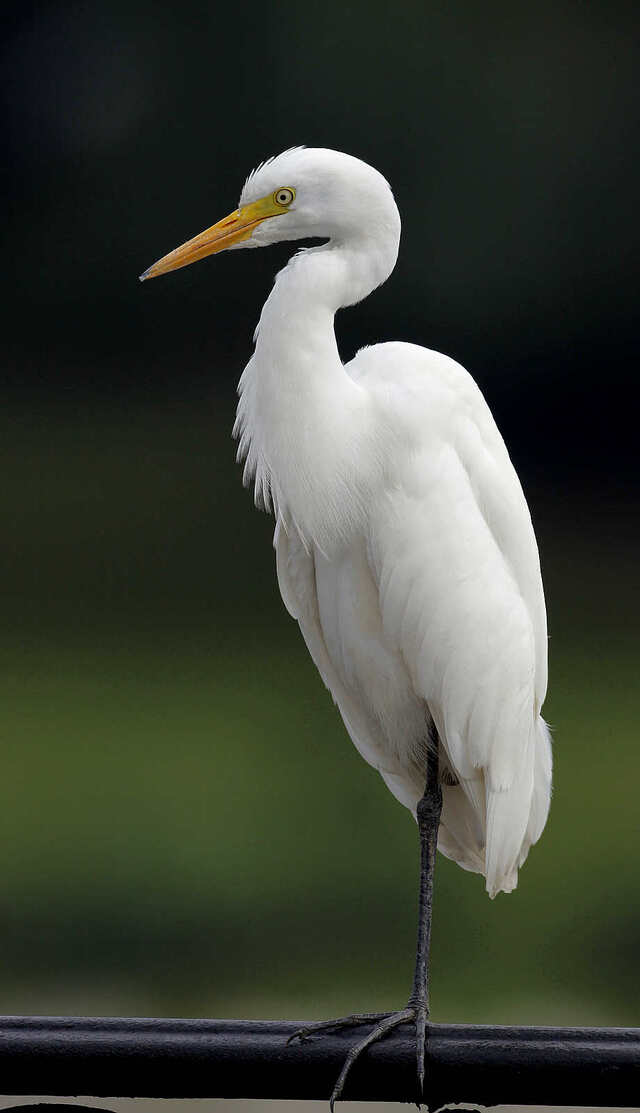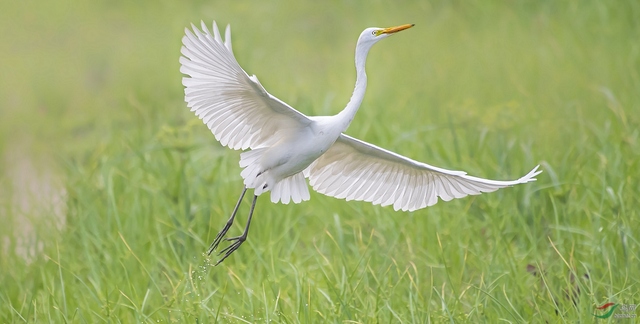Ardea intermedia
IUCN
LCBasic Information
Scientific classification
- name:Ardea intermedia
- Scientific Name:Intermediate Egret,Yellow-billed Egret。Plumed Egret,Mesophoyx intermedia、Egretta intermedia
- Outline:Wading birds
- Family:A.intermedia Ardea Ardeidae Pelecaniformes Aves
Vital signs
- length:560~720mm
- Weight:3-4kg
- lifetime:7-10years
Feature
The middle egret is a medium-sized wading bird, characterized by its size, appearance, and behavior. The middle egret is slightly larger, with a thick, short beak that does not exceed the eyes, black legs and toes, and its neck shrinks into an S shape when flying. In appearance, the middle egret's beak and feet are always black, and its toes are yellow-green.
Distribution and Habitat
It likes to appear in freshwater or brackish wetland environments with a certain degree of vegetation cover, such as rice fields, swamps, ponds, etc. It is sometimes seen in drier grasslands, and occasionally in coastal beaches and mangroves. It mainly feeds on fish, but also eats amphibians, crustaceans, etc.
Appearance
The body size is between that of the egret and the great egret. The whole body is white with yellow eyes. During the breeding season, the neck and back are covered with needle-like feathers, which fade during the non-breeding season. The beak does not exceed the eyes. The iris is yellow, the beak is black during the breeding season and yellow during the non-breeding season. The tip of the beak is black and the feet are black.
Details

Ardea intermedia (scientific name: Ardea intermedia) is a bird of the genus Heron in the family Ardeidae, and its common name is the spring hoe. Egrets are large wading birds. The body is medium in size, 560~720 mm long, androgynous; the iris is yellow, and the mouth slit does not exceed the eyes, which is one of the distinguishing characteristics of this species from the great egret; the feet are black, the body is white, and the neck is "S" shaped; The summer feathers have soft long filamentous feathers on the back and chest, the beak is black, and turns pink for a short period of time, and the exposed skin on the face is gray; the winter feathers have yellow beaks, black tips, and the feathers fade away.
The Chinese egret is distributed in Liaoning, Hebei, Beijing, Shandong, southern Henan, Shaanxi, Gansu, Tibet, Sichuan, Yunnan, Guizhou and other places in China. Medium egrets inhabit and move in shallow water areas of rivers, lakes and other wetlands; they often move alone or in small groups; they mainly feed on insects, crustaceans, molluscs, fish, frogs, lizards and other animal foods. The breeding period of the medium-sized egret is from April to June. It uses dead branches and dry grass to build disc-shaped nests on trees, bushes or on the ground. It breeds one clutch per year, laying 3 to 5 eggs per clutch, and the incubation period is 26~ 29 days.
The Chinese egret has high ornamental value. The Chinese egret is a terrestrial wild animal with important ecological, scientific and social value protected by the Chinese state. It is also a key protected wild animal in Shandong, China.
The medium egret is a medium-sized wading bird and a large heron. Its individual size is between the great egret and the white egret, and is slightly larger than the egret. The bill and neck are relatively shorter than those of the egret, the bill is long and pointed, the wings are large and long, the feet and toes are slender, the shins are partially exposed, the three toes of the feet are in front and the toe is in the back, and the claws of the middle toes have comb-like combs. edge. Hermaphrodite. The body shape is spindle-shaped, with loose body feathers and filamentous cape feathers. There are decorative feathers on the chest, some crown feathers on the top of the head, and feathers on the legs.
The whole body is white; there is a row of long cape-shaped feathers on the back of Xia Yu, extending backward beyond the tail end. There is a less obvious crown feather behind the head, and there is also a cluster of long cape-shaped feathers scattered on the chest. The winter feathers have no capris and crown feathers, with a yellow beak, black tip of the beak, and black feet and toes.
The iris is yellow; the mouth is black; the skin of the eyes is green and yellow; the feet and toes are black; the mouth is yellow in winter; the tip of the mouth is black; the feet and toes are black.
Size measurement: body length 620-700 mm, mouth peak 68-75 mm, wings 383-800 mm, tail 113-128 mm, tarsometatarsus 110-116 mm.

Habitat
It inhabits and moves in shallow water and river beaches in rivers, lakes, swamps, estuaries, seasides and pond banks, and often moves in swamps and rice fields. It is mainly found in terrestrial freshwater areas near vegetated shoals, seasonally flooded marshes, inland deltas, ponds, swamp forests, freshwater swamps, creeks, wet meadows, and flooded pastures.
This species occurs less frequently in coastal habitats but may occasionally occur on mudflats, tidal estuaries, coastal lagoons, salt marshes, tidal streams, and often inhabits mangroves.
migration
They begin to migrate to southern China to breed in late March and early April, and begin to migrate away in late September and early October. Some also spend the winter in Yunnan, Guangdong, Hainan Island and Taiwan in China.
habits
They often move alone, in pairs, or in small groups. Sometimes they mix with other herons, or live on the same island with black-tailed gulls. It is highly vigilant and will fly away when it sees people far away, making it difficult for people to get close. When flying, the neck is constricted into an S shape, the legs are stretched straight back and beyond the tail, the wings are beating slowly, and the flight is leisurely and straight. Active during the day or at dusk.
feeding habits
It feeds on aquatic organisms, mainly fish, shrimp, frogs, locusts, mole crickets and other aquatic and terrestrial insects and insect larvae, as well as other small invertebrates or small snakes, lizards, etc. It wades gently along the shallow water to look for food. It also stands quietly in the shallow water or on the water's edge waiting for prey to arrive, and then suddenly preys on it with fast and accurate movements. After eating, they often rest on the shore or on the ridge of the field with their necks curled up and standing on one foot.
Distribution range
World: Distributed in Bangladesh, Bhutan, Brunei Darussalam, Cambodia, China, Guam, India, Indonesia, Japan, Democratic People's Republic of Korea, South Korea, Lao People's Democratic Republic, Malaysia, Federated States of Micronesia , Myanmar, Nepal, Northern Mariana Islands, Oman, Pakistan, Palau, Papua New Guinea, Philippines, Russian Federation, Singapore, Sri Lanka, Thailand, Timor-Leste, Vietnam.
Traveling birds: Christmas Island, Maldives, Seychelles, United Arab Emirates, United States, Yemen.
China: Gansu, Shandong, Henan, Jiangsu, Shanghai, Zhejiang, Jiangxi, Hubei, Sichuan, Guizhou, and Fujian are summer migratory birds; Yunnan is resident bird; Guangdong, Hainan, and Taiwan are winter migratory birds.
Reproduction method
Breeding periods vary greatly from region to region. In China, they usually breed from April to June; they nest in woods or bamboo forests. Usually nests in flocks or with other herons. A shallow nest is built with branches on trees, shrubs or on the ground. The nest is disc-shaped and has a relatively simple structure. It is usually composed of dead branches and dry grass. The nest is filled with soft dry weeds. Each nest lays 3-6 eggs. The eggs are blue, white or yellow-skinned, without spots. The male and female incubate the eggs together. The chicks are late mature.
According to the measurement of 12 nests, the nest diameter is 33.75 cm × 18.25 cm, and the nest built in the bush is 35.45 (20-50) cm above the ground. Each clutch lays 2-4 eggs, most often 4 eggs. The eggs are green in color, 47.55 mm × 32.25 mm in size, and weigh 27.43 (25.7-29.4) grams. The incubation period is 26 (26-29) days, and the hatching rate is 59.1%-77.3%.








